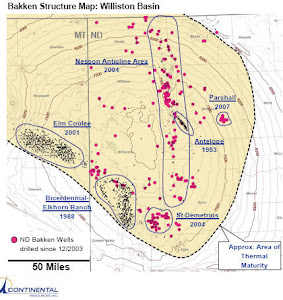The Rocky Mountain Oil Journal has graciously allowed it's article from last weeks edition to be reposted here. It provides an excellent, comprehensive summary of activity in ND during 2007:
North Dakota Oil Production Jumps 12.8% in 2007
Bakken Output Increases 329% Compared to 2006
North Dakota’s 2007 oil production recorded a healthy leap compared to a year earlier. For the year 2007, the state reported that total oil produced was 45,057,874 bo, up an impressive 5,114,464 bo as opposed to the 39,943,410 produced in 2006. These production totals makes 2007 the seventh largest year on record since the oil was first discovered within North Dakota in 1951.
Of course one of the major factors in this increase in production is the Bakken formation. According to state figures, in 2007, the Bakken is credited with producing 7,382,025 bo, up an incredible 329% compared to the 2,245,411 extracted from the same formation in 2006. This increase of over 5 million barrels bespeaks of the technological advances in horizontal drilling and more importantly, the record levels of the price of oil. The current hotspot for those operators that are chasing the Bakken are in Mountrail and Dunn Counties. Presently, of the 59 rigs that are making hole in the state, 36 of them are within these two counties looking for another Parshall field, the states largest Bakken oil pool. This field, which is in Mountrail County, is currently producing over 278 k bo per month from 21 wells and is currently under aggressive exploitation. It’s also noteworthy to point out that production within these two counties has greatly increased. In 2006, Mountrail and Dunn counties produced 415,434 bo and 984,863 bo respectively. A year later, Mountrail County reported production of 1,960,091 bo while Dunn County increased their output to 1,913,598 bo.
It should be pointed out that in 2006, the Bakken accounted for 5.6% of the states total oil output from 300 active wells. In 2007, the Bakken represented 16.6% of the states output from 457 wells. The only other formations that had a higher percentage of oil produced during 2007 was the Madison and Red River “B”. It’s anticipated that the results for 2008 will show even greater numbers for the Bakken.
Although a great deal has been written about the Bakken play within the state, it should be remembered that the Ordovician Red River “B” is still king. This formation produced 16,722,579 bo or 37.6% of the states production in 2007. In 2006, the Red River “B” cumulated 15,706,913 bo. The source of this production is coming from the Greater Cedar Creek Anticline, primary the Cedar Hills South Unit (CHSU) in Bowman County. In fact, for the month of December 2007, the latest production figures that are currently available, the CHSU produced 1,072,933 bo from 136 horizontal wells.
Of the 161 operators reporting production within the state for 2007, Burlington Resources (BR) was far and away industry’s leader. Retaining their #1 spot, BR reported production of 12,690,287 bo, up 425,475 bo compared to a year earlier. This production by BR is over twice that of the second largest producer in the state. The vast majority of BR’s production is due to the company’s aggressive horizontal Red River “B” drilling program occurring in Bowman County, however the company is getting increasingly active in the horizontal Bakken play, and has numerous prospects planned in Dunn County.
Another company who is major actor in the Red River “B” play is Continental Resources (CR). CR was second largest producer in the state, having extracted 5,146,714 bo for the year, up 1,237,361 bo compared to 2006. Aside from their activity in the Red River “B” play, CR is also a large player in the Bakken play with prospects planned or drilled in Divide, Billings, McKenzie, Mountrail and Williams County.
Hess Corporation (Hess) maintained it’s third place standing in 2007 with a yearly production of 4,189,870 bo. The majority of Hess’s production is coming from the Nesson Anticline in Williams and McKenzie counties. In 2006, Hess produced 3,528,876 bo. Hess is another company who is getting more aggressive chasing the Bakken and currently has five rigs working in Mountrail County evaluating their holdings.
Encore Operating, by virtue of their purchase of Kerr-McGee’s properties in the state, ranked number 4 with a yearly production total of 3,259,711 bo. A year earlier, the company reported that they had produced 529,439 bo.
The states fifth largest producer was Whiting O&G (Whiting). Whiting is credited with extracting 2,298,580 bo in 2007, up 105,112 bo compared to 2006. Look for Whiting’s production to increase in 2008 as the company continues their Bakken program in Mountrail County, primarily that area north of the Sanish Field area.
A quick look at drilling statistics for the state in 2007 show that a total of 407 wells were spud for the year with Dunn County leading with 70 spuds, followed by Williams County with 61. Mountrail County had 60 wells initiated and Bowman County had 56.
The following list ranks the top oil producers in the state of North Dakota for the year 2007. Please note that the company rankings for oil and gas do not include confidential wells, skimmed oil, drip gas or other liquids extracted during gas processing.
(The following is only the top 50 producers. The other 100 or so can be found at rmoj.com).


All content courtesy of the Rocky Mountain Oil Journal.





























